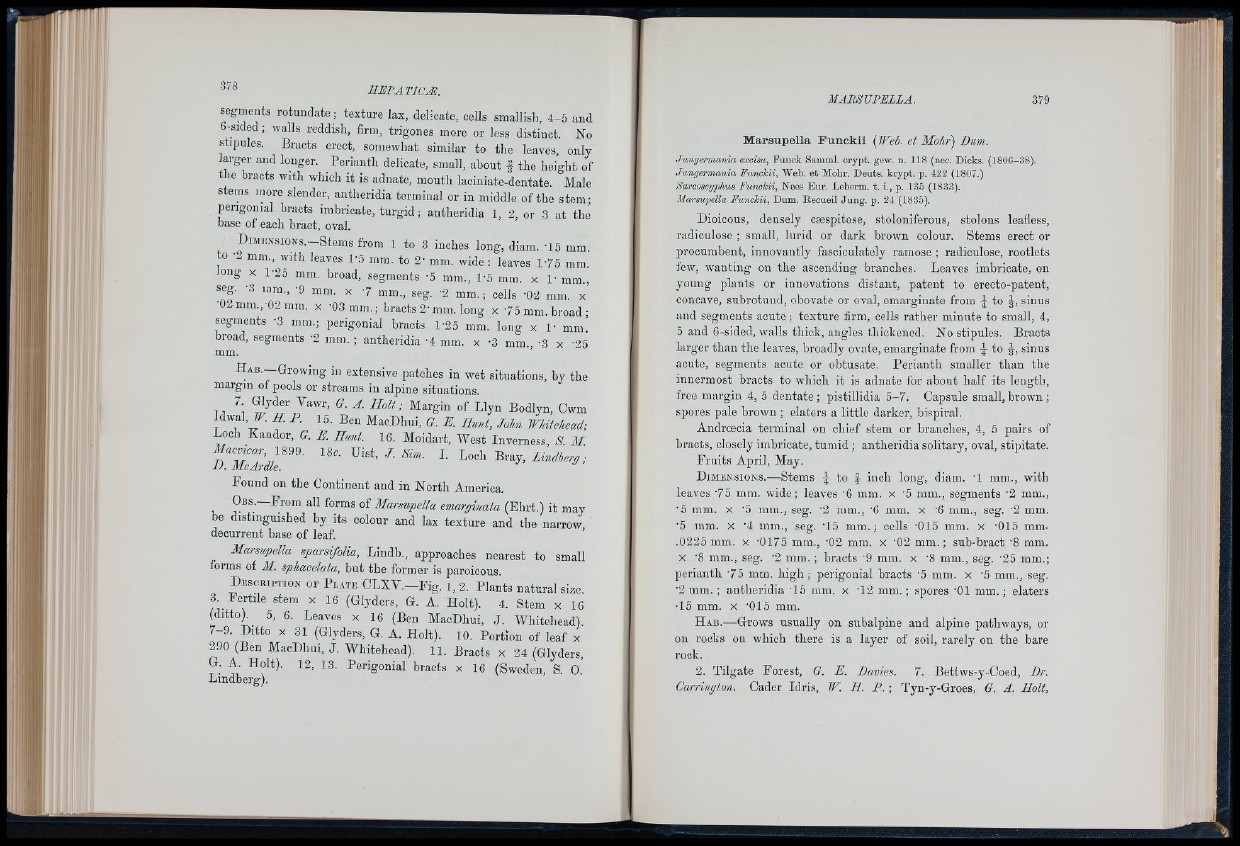
segments rotundate ; texture lax, delicate, cells smallish, 4-5 and
6-sided; walls reddish, firm, trigones more or less distinct. No
stipules. Bracts erect, somewhat similar to the leaves, only
larger and longer. Perianth delicate, small, about f the height of
the bracts with which it is adnate, mouth laciniate-dentate. Male
stems more slender, antheridia terminal or in middle of the stem;
perigonial bracts imbrioate, tu rg id ; antheridia 1, 2, or 3 at th(!
base of each bract, oval.
DiMENsroNs.-Stems from 1 to 3 inches long, diam. -15 mm.
to -2 mm., with leaves P5 mm. to 2' mm. wide : leaves 175 mm.
long X 1-25 mm. broad, segments -5 mra., lA mm. x 1' mra.,
seg. -3 mra.. A mm. x 7 mm., seg. A mm.; cells A2 mm. x
•02 mm.,-02 mm. x -03 mm.; bracts 2-mm. long x -75 mm. broad;
segments -3 mm.; perigonial bracts P25 mm. long x 1 -m m ’
broad, segments -2 mm. ; antheridia -4 mm. x -3 mm., -3 x -25
mni.
H ab.—Growing in extensive patches in wet situations, by the
margin of pools or streams in alpine situations.
Ti “ yn Bodlyn, Cwm
lawal, r . H. P. 15. Ben MacDhui, G. E. Hunt, Jolm Whitehead-,
Loch Kandor, G. E. Hunt. 16. Moidart, West Inverness, 8 M. T7e2d7'^'
Found on the Continent and in North America.
Obs.— From all forms of Marsupella emarginata (Ehrt.) it may
be distinguished by its colour and lax texture and the narrow
decurrent base of leaf. ’
Marsupella sparsifolia, Lindb., approaches nearest to small
forms of M. sphacelata, but the former is paroicous
D escription oe P late C LX V .-F ig . 1, 2. Plants natural size.
3. Fertile stem x 16 (Glyders, G. A. Holt). 4. Stem x 16
(ditto). 5, 6. Leaves x 16 (Ben MacDhui, J. Whitehead)
7-9. Ditto x 31 (Glyders, G. A. Holt). 10. Portion of leaf x
290 (Ben MacDhui, J. Whitehead). 11. Bracts x 24 (Glyders,
G. A. Holt). 12, 13. Perigonial bracts x 16 (Sweden, S. 0.’
Lindberg).
Marsupella Funokii [Web. et Mohr) Dum.
Jungerrmnia excisa, Funck Samml. crypt, gew. n. 118 (nec. Dicks. (180C-38).
Jungermania Fv.rtckii, Web. et Mohr. Dents, krypt. p. 422 (I8Ü7.)
Sarcoscyphus Funckii, Nees Eur. Leberm. t. i., p. 135 (1833).
Marsupella Funckii, Dum. Eecueil Ju n g . p. 24 (1835).
Dioicous, densely cæspitose, stoloniferous, stolons leafless,
radiculose ; small, lurid or dark brown colour. Stems erect or
procumbent, innovantly fasciculately ramose ; radiculose, rootlets
few, wanting on the ascending branches. Leaves imbricate, on
young plants or innovations distant, patent to ereoto-patent,
concave, subrotund, obovate or oval, emarginate from J to sinus
and segments acute ; texture firm, cells rather minute to small, 4,
5 and 6 -sided, walls thick, angles thickened. No stipules. Bracts
larger than the leaves, broadly ovate, emarginate from to -J-, sinus
acute, segments acute or obtusate. Perianth smaller than the
innermost bracts to which it is adnate for about half its length,
free margin 4, 5 dentate ; pistillidia 5-7. Capsule small, brown ;
spores pale brown ; elaters a little darker, hispiral.
Andrcecia terminal on chief stem or branches, 4, 5 pairs of
bracts, closely imbrioate, tumid ; antheridia solitary, oval, stipitate.
Fruits April, May.
Dimensions.-—Stems J to | inch long, diam. •! mm., with
leaves -75 mm. wide; leaves -6 mm. x -5 mm., segments -2 mm.,
•5 mm. X -5 mm., seg. -2 mm., -6 mm. x -6 mm., seg. '2 mm.
•5 mm. x -4 mm., seg. -15 mm.; cells -015 mm. x -015 mm-
.0225 mm. x -0175 mm., -02 mm. x -02 mm.; sub-bract -8 mm.
X -8 mm., seg. '2 mm. ; bracts -9 mm. x -8 mm., seg. -25 mm.;
perianth '75 mm. high; perigonial bracts '5 mm. x -5 mm., seg.
•2 mm. ; antheridia -15 mm. x -12 mm. ; spores -01 mm. ; elaters
-15 mm. x -015 mm.
H ab .—Grows usually on subalpine and alpine pathways, or
on rocks on which there is a layer of soil, rarely on the bare
rock. 2. Tilgate Forest, G. E. Davies. 7. Bettws-y-Coed, Dr.
Carrington. Cader Idris, W. 11. P. ; Tyn-y-Groes, G. À. Holt,